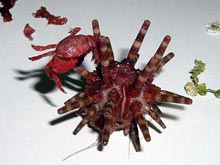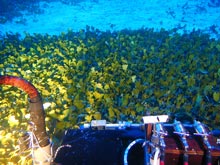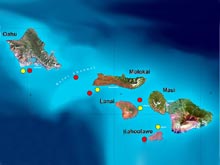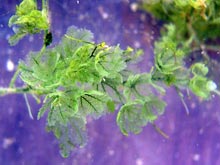
View a slideshow of deep water dives, marine life and other highlights from this cruise.
![]() Click image to view a slide show.
Click image to view a slide show.
Locations surveyed for deep water algae with the submersibles (red) and remotely operated vehicle (yellow) in Hawaii. The islands of Molokai, Maui, Lanai, and Kahoolawe form the Maui Nui island complex, and appear to have a similar deep water flora as compared to Oahu. Click image for larger view.
Exploration of Deep Water Macroalgal Meadows - Main Hawaiian Islands 2004
Cruise Summary and Results
Leg I: September 3-7, 2004
Leg II: December 13-17, 2004
Heather Spalding
Chief Scientist
University of Hawaii at Manoa
The waters surrounding the Hawaiian Islands are rich with a high diversity of tropical algae (seaweed, or limu) and are relatively clear, allowing algae to occur to depths over 200 meters. Incidental surveys revealed expansive meadows of native and invasive algae covering tens to hundreds of kilometers of the ocean floor. Species composition, abundance, and temporal and spatial dynamics of the deep-water flora, however, are poorly understood. A thorough investigation is necessary to clearly understand near-shore primary productivity, habitat use by fish and invertebrates, carbonate sand production by calcified algae, soft sediment nutrient sources, algal biodiversity, biogeography, and the occurrence of invasive non-indigenous algae. Given the high rates of endemism (species unique to a region) in Hawaii, many of these undiscovered species may be new to science. NOAA's Office of Exploration and the Hawaii Undersea Research Laboratory (HURL) funded two expeditions in the main Hawaiian Islands totaling 10 days at sea aboard the R/V Ka'imikai-o-Kanaloa to explore and collect deep water algae and associated organisms in Hawaii using the submersibles Pisces IV, Pisces V and the Remotely Operated Vehicle (ROV) RCV-150. An innovative sediment water pore water sampler was designed and deployed with the submersible manipulator arm to determine the chemical composition of sediment inside and outside of macroalgal meadows.
A total of nine submersible surveys and five ROV surveys were completed at 9 different locations throughout the Main Hawaiian Islands. Some sites were sampled during both September and December cruises to account for variations in algal abundance by season. Over 30% of the large macroalgae collected were new reports for Hawaii or new species to science. Expansive, luxuriant meadows of a number of different macroalgal species were discovered for the first time off the islands of Oahu, Molokai, Maui, Lanai, and Kahoolawe. Small fish, such as wrasses, were observed using algal meadows for habitat, and a school of large jacks were observed foraging for prey in the Halimeda kanaloana (formerly Halimeda incrassata) meadows.
Deep water algal meadows provide structural complexity over otherwise featureless expanses of sand, and appear to serve as an important food source, habitat, or substrate for fishes and invertebrates in Hawaii. Given their high abundance and coverage over sandy sediments, they may also have a profound effect on sediment nutrient dynamics. Nutrient data from sediment porewater and overlying seawater collected from vegetated and nonvegetated sites suggest that some species of algae may be involved in oxygenating the surrounding sediment. Algal involvement may change the availability of different types of nutrients in the sediment, and possibly affect surrounding organisms living in the sediment.
The major discoveries made during the expedition include:
- Expansive meadows of the calcified green alga Udotea sp. and the invasive green alga Avrainvillea amadelpha were discovered for the first time in deep water off south Oahu. This is the first report of the genus Udotea in Hawaii. These species were found over sandy substrate from 28 to 80 m depths with up to 100% cover. Future studies will determine if the two species compete for space, light, or nutrients.
- Halimeda kanaloana meadows were found from 15 to 90 m depths throughout the islands of Molokai, Maui, Lanai, and Kahoolawe (or the Maui Nui island complex). These meadows have not been described anywhere else in Hawaii, and appear to be unique to this area. Algal canopy heights ranged from 20 to 30 cm. Numerous red, green, and brown algal epiphytes were found growing on the Halimeda, and their abundance decreased with increasing depth. The large coverage of this species and its high productivity suggest it may be a significant sand-producer in this region.
- Over 30% of large macroalgal species collected were new records for Hawaii or new to science. Some completely undescribed large red algae were observed with the ROV and unable to be collected. We hope to go back to some of these areas to collect the mysterious red algae.

These Udotea sp. meadows were discovered off of Oahu to depths of 80 to 90 m. This is the first report of this genus in Hawaii, and we found it covering several kilometers of the sea floor. Little is known about distribution of this species in deep water, or what role it may play ecologically in Oahu. Click image for larger view.
- Numerous fish, invertebrates, and turtles were observed using algal meadows for food and/or habitat. Certain structural forms of algae, such as the upright, branched Halimeda kanaloana, and the leafy Udotea sp., appeared to form better habitat for small fish than other forms of algae. Some of these meadows appear to increase the diversity and abundance of organisms as compared to bare, sandy substrate.
- A new innovative sediment pore water sampler was deployed by the submersible Pisces V to determine chemical profiles for the sediment inside and outside of macroalgal meadows. This is the first step towards understanding the effect of macroalgal meadows on surrounding sediments, and the abilities of sand-dwelling algae to absorb sediment nutrients. This new technique may prove useful in other environments with conductive sediments.
- Surprisingly, the deepest alga discovered on this expedition was the green alga Cladophora sp. at 212 m depth. This is the deepest this alga has ever been recorded. Cladophora was particularly abundant over hard substrate from 150 to 212 m depths in September. This alga can be invasive and form seasonal blooms in shallow water in Maui. However, there was no bloom occurring in shallow water at the time of the surveys, suggesting that deep water populations may be separate from shallow water, and perhaps operate under different environmental cues.
- The green alga Ulva sp. was one of the most widespread species, occurring to a depth of 191 m and forming large, seasonal blooms from 65 to 80 m depths in some areas. Ulva is typically considered an intertidal species. Its high abundance in specific areas suggests nutrient-enriched groundwater flux occurs into these deep water environments.
These exciting discoveries form the basis for a quantitative description of deep water algal assemblages and associated macrofauna. This knowledge can be used to describe habitats and monitor changes in the community structure over time. Our project encompasses science education coupled with Hawaiian cultural studies in a first-time exploration of a macroalgal dominated deep-water ecosystem in the tropics. Future expeditions in 2006 will explore additional locations in the Main Hawaiian Islands with submersibles, ROVs, and technical SCUBA divers to determine the spatial and temporal distribution of these exciting communities.








